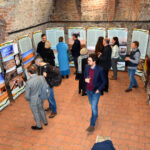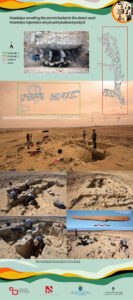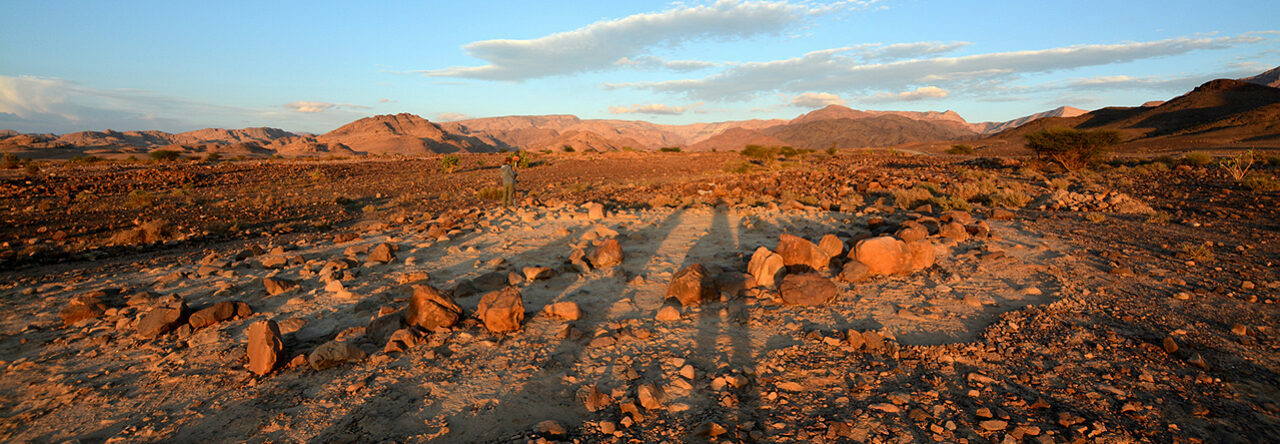 The exhibition follows on from a project that aimed to better characterise the environmental processes that took place in the early and middle Holocene in southern Jordan and southern Poland.
The exhibition follows on from a project that aimed to better characterise the environmental processes that took place in the early and middle Holocene in southern Jordan and southern Poland.
This provides a better understanding of the dynamics of cultural phenomena that are discernible during this period in these areas. To this end, members of the team took part in study trips, during which lectures were held to illustrate the cultural situation against the background of environmental changes in these areas. During these discussions, comparisons were also made between the most important environmental factors influencing cultural phenomena, such as landforms, soil cover, available raw materials, the state and changes of the climate, the hydrological network and flora and fauna. The team members exchanged experiences in the study of environmental processes and contexts, and reconstructions of the impact of natural conditions on Neolithic, Aeneolithic/Chalcolithic and Early Bronze Age communities operating at the two sites.
Since 2014, researchers from the Institute of Archaeology at the Jagiellonian University have been carrying out surface and excavation work in southern Jordan. The aim of this work is to create a coherent picture of how human groups functioned in the region. The fieldwork, which is carried out annually, includes both surface surveys, documentation of sites (using modern techniques such as GIS, among others) and excavations. To date, to a greater or lesser extent, sites such as: Faysaliyya, Munqata’a, Umm Tuweyrat, Huseinya, as well as one of the sites in Wadi Feynan, which contains copper mines from the Neolithic and Bronze Age periods. During recent seasons of research, scientists from the Jagiellonian University have come across a set of dolmens from the Late Neolithic, Chalcolithic/Eneolithic and Bronze Age periods in the project area. Thanks to their analysis, it seems possible to reconstruct the process of erecting these stone structures, as well as to determine their function and significance, as some of the structures have burials and remains of ceramic vessels, animal bones or flint tools inside. These discoveries encourage the thesis of the key role of the landscape and its natural rock formations in the functioning of the prehistoric communities of southern Jordan
 Some members of the Polish part of the team are also carrying out important archaeo-environmental research in southern Poland. These have brought significant discoveries in recent years, building our knowledge of the functioning of human groups in the Neolithic and Aeneolithic periods in this area. A number of palaeogeographic analyses (e.g. geomorphology, palaeobotany, palaeozoology) were made in the course of research on a large settlement of the Funnel Cave culture in Mozgawa (Pińczów poviat) and on a multicultural settlement in Miechów. Particularly noteworthy is the acquisition of palynological profiles from the immediate vicinity of these sites, which is rare in the loess zone. During the research carried out on the settlement of the population of the ribbon ceramic culture in Biskupice (Wieliczka district), a number of similar palaeogeographic studies were also carried out. Particularly noteworthy in this case are detailed geomorphological analyses, which make it possible to reconstruct the original topography of the settlement area and the appearance of the hydrological network in its immediate vicinity. All such environmental studies make it possible – on selected examples – to grasp the environmental contexts of Neolithic and Aeneolithic settlements and to estimate their role in archaeologically discernible Neolithic and Aeneolithic cultural transformations.
Some members of the Polish part of the team are also carrying out important archaeo-environmental research in southern Poland. These have brought significant discoveries in recent years, building our knowledge of the functioning of human groups in the Neolithic and Aeneolithic periods in this area. A number of palaeogeographic analyses (e.g. geomorphology, palaeobotany, palaeozoology) were made in the course of research on a large settlement of the Funnel Cave culture in Mozgawa (Pińczów poviat) and on a multicultural settlement in Miechów. Particularly noteworthy is the acquisition of palynological profiles from the immediate vicinity of these sites, which is rare in the loess zone. During the research carried out on the settlement of the population of the ribbon ceramic culture in Biskupice (Wieliczka district), a number of similar palaeogeographic studies were also carried out. Particularly noteworthy in this case are detailed geomorphological analyses, which make it possible to reconstruct the original topography of the settlement area and the appearance of the hydrological network in its immediate vicinity. All such environmental studies make it possible – on selected examples – to grasp the environmental contexts of Neolithic and Aeneolithic settlements and to estimate their role in archaeologically discernible Neolithic and Aeneolithic cultural transformations.
For several years now, extremely important discoveries have also been made by a team whose members are Jordanian collaborators of the Krakow researchers. Last year, the scientific world was abuzz with reports of an important new archaeological discovery made by them in the south-eastern part of Jordan, where a Neolithic stone sculpture complex dating back 9,000 years was discovered. The find has been hailed as one of the most important discoveries of recent years in the Levantine zone. The scientists conducting research there believe that the site is a unique ritual ‘installation’ dedicated to the hunting of gazelles. The boulders found there are, according to them, models or real traps, which, according to the scientists, are some of the world’s oldest monumental sculptures built by humans. Nearby, encampments used by Neolithic hunters, whose lives centred around hunting activities, have been discovered. These people lived in semi-terrestrial circular huts, where they left significant quantities of stone tools and animal bones. Jordanian archaeologists say the new discovery gives us an insight into the creative minds and extraordinary spiritual expression of the area’s inhabitants during the Neolithic period. They also show how important the surrounding animate and inanimate natural world was to the prehistoric hunters.
The work of the above-mentioned Polish and Jordanian teams clearly shows that the changing environmental conditions over several thousand years (from the Early Neolithic period to the Bronze Age) played an important role in the functioning of human groups, sometimes imposing specific adaptations to the often difficult natural conditions. They underpinned such cultural elements as architecture, clan and social rituals, funerary rites, contacts with neighbouring communities and ways of pursuing economic activities. A growing body of evidence points to their direct influence on the way people of the time perceived the world around them and attempted to reflect natural phenomena in objects, beliefs or buildings. Not insignificant are also the conditions in terms of natural resources, which underpinned certain states of flint manufacture, pottery production, but also stimulated the development of certain elements of the food economy or long-distance trade (e.g. exchange based on raw copper or obsidian).
The data acquired in recent years from the Polish and Jordanian sites encourage us to reflect on the role of environmental phenomena and changes during the Neolithic, Chalcolithic/Eneolithic and Early Bronze Age periods. The exchange of experience between Polish and Jordanian researchers and leaning in workshop conditions on such data sources as geomorphology, petrography, palaeoclimatology, hydrology, palaeobotany and palaeozoology will become an important element of this activity. The joint analysis of the ways in which prehistoric communities adapted to changing natural conditions in areas that today differ significantly in terms of their natural environment will contribute to a better understanding of cultural phenomena observed by researchers in these areas, and will form the basis for further joint projects aimed at finding answers to questions on the roots, contexts and conditions of human culture in all its manifestations.
Project leader: Dr. Marek Nowak, Professor at the Jagiellonian University, Institute of Archaeology, Jagiellonian University
Authors of photographs, reconstructions and texts: Marek Nowak, Piotr Kołodziejczyk, Wael Abu-Azizeh, Mohammad Barakat Tarawneh, Magdalena Moskal-del Hoyo, Agnieszka Brzeska-Zastawna, Klaus Cappenberg, Marcin Czarnowicz, Magda Kapcia, Jacek Karmowski, Robert Kenig, Marta Korczyńska-Cappenberg, Igor Pieńkos, Marcin M. Przybyła, Melanie Roffet-Salque, Adam Walanus, Michał Wasilewski, Dagmara Werra, Jarosław Wilczyński, Barbara Witkowska, Justyna Zakrzeńska.
This exhibition has been funded by the Department of History within the framework of the Strategic Initiative for Excellence at the Jagiellonian University.
